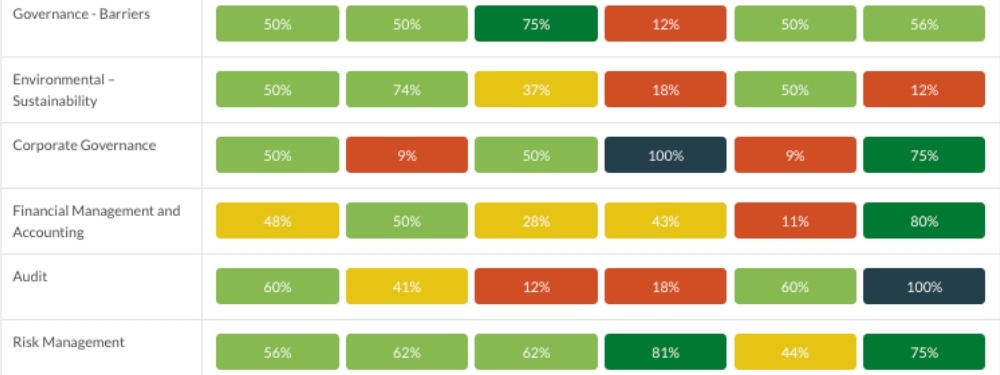Board Composition
When discussing board composition, the following topics should be considered:
GovernWith blog for Boards, Directors and Executives who want to develop their governance capabilities, achieve their strategic goals and mitigate risk.
Posts about:

When discussing board composition, the following topics should be considered:

Australian Boards face mounting pressure to strengthen corporate resilience amid economic, technological and regulatory disruptions in 2025.

In March 2025, the Australian Prudential Regulation Authority (APRA) released a Governance Review Discussion Paper outlining proposals for enhancing governance frameworks within financial institutions. Among these, Proposals 1 (Skills and Capabilities) and 5 (Board Performance Review) both stand out as particularly significant. GovernWith’s Governance Review, Director Skills Matrix and External Evaluation services are specifically designed to provide comprehensive, contemporary and accessible governance assessments. These solutions not only meet APRA’s expectations but also help our clients meet regulatory requirements while strengthening overall governance effectiveness.

This article explores the term Governance Evaluation and examines its significance in maintaining the integrity of the Australian business environment. In business and legal settings, it is crucial to start with clear definitions, so here we go.

Coming out of the 2023 GovernWith Contemporary Governance Risks Whitepaper, there was an interesting phenomenon we saw trending through the data. The data collected had more than 2,000 individual contributions across both the Board Governance Review and the Director Skills Matrix. These two assessments meet two different criteria and require different “context hats” worn when completing them. The Board Governance Review is answered by an individual’s gauge, or evaluation, of how assured the board is that the whole organisation (board and executive included) are delivering on their Corporate, Sector Specific and Contemporary Governance roles and responsibilities. The Director Skills Matrix is answered by an individual considering their own understanding, qualifications and experience in relation to their Sector, Professional and Contemporary skills, measuring their level of capability.
While not entirely reflective of the psychological definition “an individual being less likely to help a person in need while in the presence of others”, the core message that bystanders often assume someone else will step in, is what we want to highlight.
The diffusion of responsibility, particularly in contemporary governance issues, was demonstrated when comparing an individual’s view of the organisation’s capacity overall - often being quite positive, yet individually most in these same areas indicated their own capabilities were foundational. This emphasises, and gives evidence to, an attitude of pluralistic ignorance where boards may not have the ability to recognise or ask the right questions around trends and issues, if each of them is expecting another to have the educated knowledge and experience to be the voice in those areas.
If a board has reflected in the Governance Review that the organisation are highly proficient in a particular area, but the group results of the individual skills matrix indicate most directors are foundational in their own capabilities - these results don’t align and give urgency to the risks and impact of bystander thinking.
What a fantastic opportunity we have through this data in how we can individually reflect and respond. Shown through centuries of evolution and human behaviour we witness the ultimate benefits of being altruistic, curious and community serving. It’s up to each of us to make having an educated foundation for our thinking important, and to show initiative in seeking out that self development. These human centric trends and issues we see at the forefront of governance now are everybody’s responsibility. For a board, executive and whole organisation to be its most capable and sustainable, every member needs to be a participator in their ongoing development, training and preparation in contributing to these conversations. In 2024 our goal at GovernWith is to ignite and support proactive participation, leaving bystander apathy behind in 2023.

In our increasingly interconnected world, the importance of socially responsible and sustainable business practices is gaining more attention than ever before.
We have had close to 1000 Directors complete our Board Governance Review and Director Skills Matrix. The results around ESG continually indicate a need for development in the awareness and capabilities of those at the Boardroom table, to contribute and think strategically in this area.
When prompting further discussion, the most common question is "What on earth is ESG?".
What is ESG?
ESG stands for Environmental, Social, and Governance trends and issues. The handprints (Social) and the footprints (Environmental) of an organisation.
Environmental indicators look at how a company performs in the sustainability of our natural world. It may include waste management, energy use, consumerism, climate change mitigation and handling of extreme events.
Social indicators examine how a company manages relationships with its stakeholders: employees, suppliers, customers, and the communities, through its operations. They may look at issues such as workforce (retention and HR practices), cybersecurity, social inclusion and diversity, modern slavery, minority groups, gender equity, First Nations people and community development.
Australia is no stranger to the growing importance of ESG.
The country’s exposure to environmental risks, such as covid, bushfires and floods has amplified the need for organisations to consider environmental factors in their strategic planning.
Australia’s social issues, including the reconciliation with its First Nations people and ever growing cyber hacking crime, also play into the policies and strategies seen more and more by those at the boardroom table.
Why is ESG important for boards and organisations?
Risk Management: Being aware of, and understanding ESG trends and issues help companies identify potential risks that may arise from environmental damage, social issues, and poor governance. By proactively, strategically addressing these factors, organisations can mitigate these risks and secure their long-term sustainability.
Workforce: Understanding that staff are key stakeholders of an organisation and therefore, representing their voice, diversity, gender equity and inclusion is crucial. This starts at a board level. Reducing churn, increasing retention and building a strong work place culture, the handprint of an organisation is most strongly reflected through prioritising the voice of its staff, and its ability in not only implementing but encompassing ESG principles.
Investor Appeal: There is a growing trend of investors favouring businesses that uphold ESG principles. Companies demonstrating strategy, process and mission statements around these principles can potentially attract more investment, boosting their success.
Regulatory Compliance: With an increasing focus on sustainability, governments worldwide, including Australia, are introducing more stringent regulations related to environmental protection, social issues, and governance. By adopting ESG principles, organisations can ensure they stay ahead of regulatory changes and avoid penalties. Coming into 2024 we are seeing an increase in these mandatory requirements such as Climate Change and Modern Slavery.
Reputation and Stakeholder Engagement: Companies known for their commitment to ESG principles enhance their reputation, which lead to increased consumer loyalty, better relationships with stakeholders - including workforce, and overall business success. Reputation is more exposed than ever before, while also becoming more intrinsically tied to the integrity of how organisations embody ESG. This again ties back to investor appeal and the long term sustainability of the organisation.
What are the key questions we need to ask first?
As the world continues to change and evolve, so does the definition of good business practice. By developing ESG strategies and practices, boards and organisations in Australia can build sustainability while contributing positively to its community.
Things to initially consider:

Recent Royal Commissions in banking, education and other institutions have led ASX to revise their Corporate Governance Principles to recommend board and director evaluation and development take place annually across all sectors to support good governance.
But which evaluation method is best suited to your needs?
A quick google search will return a multitude of methods by which an organisation may evaluate its board and director performance. Governance Evaluator takes a look at the pros and cons of the most popular evaluation options to help you make an informed decision for your organisation.
Many organisations with very early governance maturity, or with very limited resources, may choose to ‘dip their toe’ into evaluation via an internally sourced and managed survey. Resource hubs such as VCOSS and ourcommunity.com.au offer free of charge quizzes and fact sheets that give boards a good initial overview of their level of functioning.
Pros: Suits the smallest budget. Provides a general overview of collective governance performance. Fact sheets may provide information about areas for development. Tackles the initial issue of ‘not knowing what you don’t know’.
Cons: Content of questions and resources generic and basic, not tailored for specific industries or addressing specific issues. Can be cumbersome to complete and report upon. Lacks an external perspective. Can be time consuming to compile responses and turn into useful data for decisions about future actions. Provides no ongoing trending or benchmarking.
Similarly, boards at an early level of governance maturity may decide to hold a board discussion where a group consensus is sought in relation to the board’s performance on key governance requirements. At this or a subsequent session, the board would agree on actions to address issues raised.
Pros: Can be completed in a short period of time. Does not require additional investment other than time. Helps the board go from not knowing what they don’t know, to identifying as a team what the issues are; ie ‘knowing what they don’t know’.
Cons: Discussion & actions can be skewed by more influential participants. Lacks an external perspective. Focuses on collective board performance and does not address individual director skills and experience.
Some more mature boards may engage an external consultant to manage the evaluation and development process from end to end, or facilitate specific milestones throughout the process. Consultants may be governance experts or industry experts, but ideally would be both. Consultants provide a guiding hand for boards who know they need to evaluate, but are limited by experience or time to manage the process themselves. Peak bodies are a good source for recommending consultants who have experience in the industry. Governance Evaluator is proud to offer independent consultants as a supplement to our board and director evaluation processes.
Pros: An external perspective of governance performance against relevant legislation and frameworks. Adds rigour and reduces subjectivity of the process. Expert guidance to enable the board to move beyond evaluation and into targeted capability building & development. Can assist the board to go from ‘not knowing what they don’t know’, to ‘knowing what they don’t know’, to developing strategies to address the identified issues.
Cons: Can be expensive. Can be labour intensive. In some instances, the board may be left to write an action plan themselves, or are left with a generic action plan that is relegated to the bottom drawer until next year.
Self-assessment is recognised by Aon, ASX, DHHS and AICD as well as peak bodies in health & age services (LASA, VHA, ACHG, AHHA), community (ACNC) and education (NESA) as a sound method for understanding and improving a board’s performance, as well as the skills and experience of individual directors.
Some online tools available offer flexibility and ease of data collation and analysis. In addition, some tools can tailor their content to the specific requirements of board’s sector, and provide data and insights for boards to trend and benchmark their performance historically, as well as against others in their sector and across industries.
Care must be taken to ensure that the self-assessment tool avoids the influence of subjectivity. This can be achieved through careful questionnaire design and analysis. To find out more about how leading self-assessment techniques achieve this, click here.
Outputs of the self-assessment inform actions to build board capabilities where they are needed most. Governance Evaluator is founded on effective online self-assessment of board and individual director performance.
Pros: Affordable. Can be managed internally if desired. Outputs enable the board to move beyond evaluation and into targeted capability building & development for the collective board as well as individual directors.
Cons: Requires engagement in the process by board members. Can be subjective, unless it is part of a multi-faceted evaluation & capacity building process.
As you can see, there are options available to suit all levels of governance maturity and investment capabilities. To discuss the best board evaluation and development program for your board, book in for a 15-minute governance health check below.